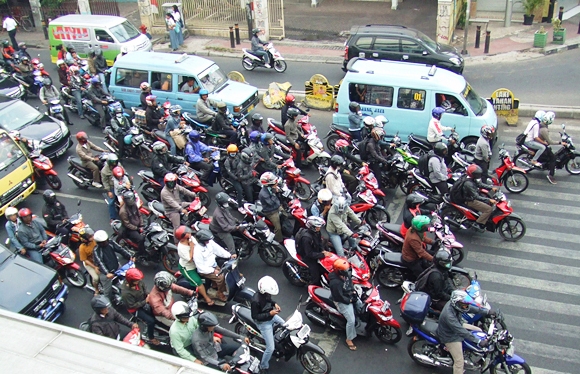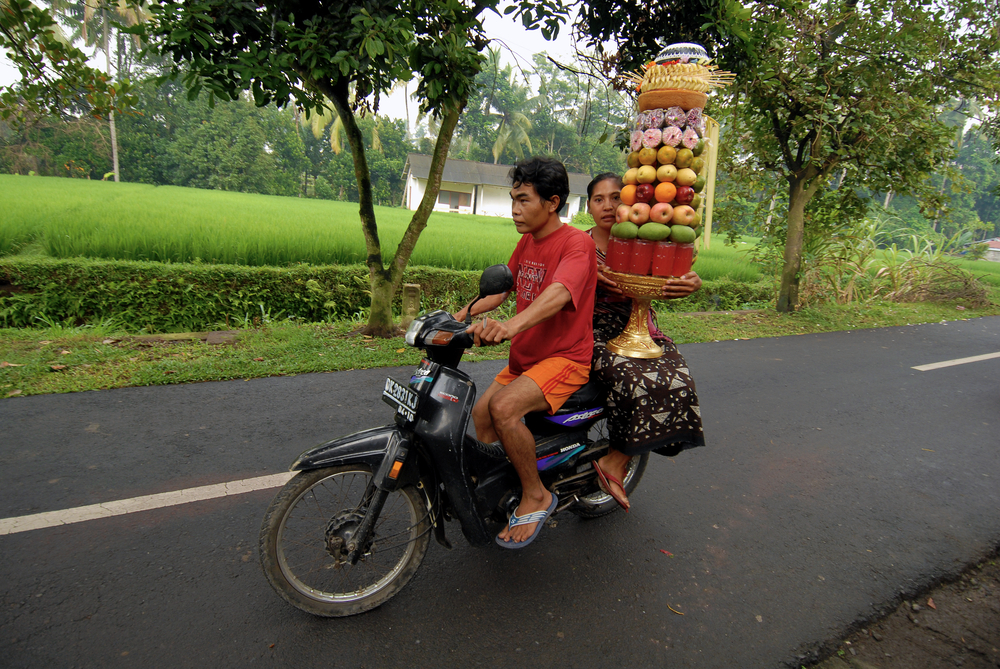|
Most guide books to Indonesia advise foreigners against driving in Indonesia. They make this recommendation on the basis of the notion that “there are no rules” here for driving. Latitudes, however, has recently discovered a copy of the traditional Indonesian driving code, the Dharma Ningmarga, in a newly-excavated candi near Modjokuto, Java and has commissioned its translation from the original Kawi script into English as a service to the nation and its inhabitants.
1. Right of Way
In driving, as in all other aspects of Indonesian life, there is a natural hierarchy. Right of way should at all times observe the following order of preference: 1. army vehicles 2. police in cars with guns 3. demonstrations by the Islamic Defenders Front 4. Balinese ritual processions 5. large trucks with Rambo painted on the back 6. police on motorbikes with guns 7. large trucks with scantily-clad women painted on the back 8. BMWs with government-issue license plates 9. huge tourist buses 10. small local buses with no brakes 11. pickup trucks with more than twenty people in the back 12. pickup trucks with more than 200 chickens in the back 13. motorbikes with drivers under sixteen 14. motorbikes (Honda) 15. motorbikes (Vespa) 16. motorbikes with more than five passengers 17. demonstrations by the Jakarta Stockbrokers Alliance For Social Justice 18. police on motorbikes without guns 19. bicycles 20. roving meatball vendors 21. fire trucks (if there were any) 22. ambulances (if there were any) 23. dogs 24. pedestrians

2. Merging
When merging, observe the “right of way” rules above. Look straight ahead and pretend you don’t see the vehicles to either side of you. Under no circumstances should you make eye contact—to do so might give other drivers the impression that you’re sympathetic with their plight and encourage them to go first.
3. Use of Lanes
Indonesian traffic shall at all times, regardless of direction, aim for the center of the road. In the absence of lane markers (which there is) the center of the road may be gauged by using one’s kesaktian or “inner power.”

4. Overtaking
Overtaking other vehicles (including those who have just overtaken you) is a civic duty. One should leave no more than ten centimeters between cars and no more than five centimeters between one’s car and pedestrians. Overtaking around blind curves, during tropical rainstorms and in heavy traffic earns one the title of “road warrior for national pride.” After overtaking, one should travel in the wrong lane for as long as possible. Swerving back to the left should be done when death is but a blink away, leaving no more than the aforementioned ten centimeters between oneself and the car behind.
5. Road Signs
Directional signs placed by the government are part of a state plot to confuse the masses. Ignore them. Instead, rely on these populist indicators: 1. A big pile of rocks in the middle of the road (usually around a blind curve) = hole in the road ahead. 2. A big pile of tree branches in the middle of the road = broken-down car ahead. 3. A bamboo pole positioned across the road (visible only from two meters away) or a combustible kerosene lantern in the middle of the road = bridge collapsed ahead.
6. Use of Headlights
1. Flicking on and off your headlights in the daytime = police up ahead. This is often combined with finger signs: one finger means get ready with Rp50,000, two fingers means get ready with Rp10,000, three fingers means get ready with Rp100,000. 2. Turning your headlights on during the daytime when approaching an intersection or while overtaking other vehicles means “I’m really going to go so don’t even think about messing with me.” When the oncoming car turns on their headlights as well, this meaning of this signal is upgraded to “I’m really going to go and I’m ready to die for my right of way and take you with me.” 3. Keeping the headlights on continually in the daytime means there is a sick passenger in the car on the way to the hospital and the driver will be undertaking maneuvers designed to make sure the patient will have company. 4. Driving at night with no headlights means (for adults) “I couldn’t afford to replace my broken headlights but I really wanted to go out anyway” or “I am so drunk I forgot what little I once knew about driving” or (for teenagers) “the color black is cool.”
7. Use of Horn
Continual use of the horn reflects the fact that Indonesians are an inherently musical people. Like gamelan music, horn-blowing follows a complex code. A. Short, self-confident, repetitive blasts are used to indicate social supremacy over dogs, pedestrians and smaller vehicles blocking one’s way. B. Single, long mournful blasts are used as supplication to oncoming trucks in one’s lane. C. Single, short, casual blasts mean “I have spotted someone out of Indonesia’s 210 million whom I think I know” or “I have not blown my horn in more than three minutes.” D. For trucks, all horn-blowing has the same meaning, i.e., “be aware that I have no intention of stopping even if I could.”
First published in Latitudes Magazine
|













